In the last week (July 3-8) we’ve made it from Desolation Sound to the Broughtons, passing through the last major hurdle of our trip – four tidal passes (where rapids can form), parts of the notorious Johnstone Strait with its high winds and challenging tide rips, and many kinds of weather including northerlies, southerlies, and rain. In a way it felt like we’d run the gauntlet, in terms of encountering a new sailing challenge or weather condition every day.
We were never bored, and if we had done this with less experience (ie, a year ago), we probably would have been often scared. But thanks to more experience and preparation, things overall went really well.
This post will be mainly about our route – and fairly technical (more of interest to other sailors planning to do this passage). Our route is certainly not the only one possible and many choose to do it differently, but I figured the reasoning behind our routing might be interesting. In researching beforehand I hadn’t been able to find many accounts of people’s actual routing choices in cruising guidebooks or blogs.
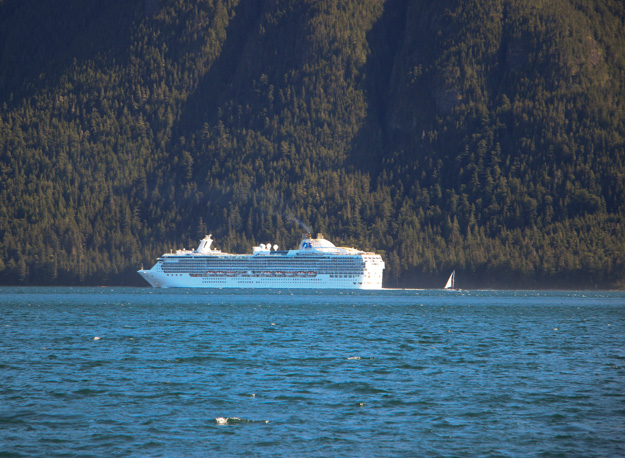
A view from Port Neville. Yes there is a sailboat (flying genoa only) behind that cruise ship. Really puts into perspective how big the cruise ships are.
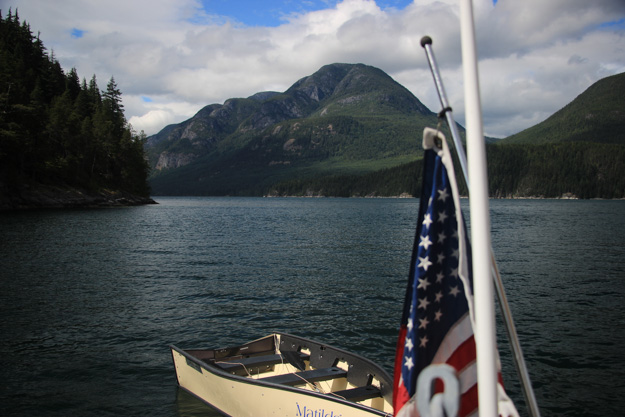
Celebrating the Fourth of July in Forward Harbor
Tidal Currents
Understanding tide and currents is important anywhere in BC or the Puget Sound, but going through the rapids on the back route to the Broughtons, or through Johnston Strait, it becomes much more important. This is still one area we struggle with sometimes. The currents often seem to be doing different things than what the tide tables and current stations say they should be doing. The tidal movements in this area are extremely complex – in Johnston Strait you can have surface ebbs while a flood is going on, or it could be flooding on one side of the strait while it’s ebbing on the other side. And if you miss slack at a rapids by just 30 minutes it could already be moving at 2 knots; miss it by an hour and it could be moving at 5 knots.
Here’s an example of a typical route planning question we have to determine the answer to: If you need to sail 10 miles north in Johnston Strait with a 15-25 kt wind blowing from the north, would you go when the current is flowing north (ebb) or when it’s flowing south (flood)? I thought the right answer was the ebb. While current opposing wind (current going north, wind going south) is well known to be a recipe for short waves and tide rips, surely that would be better than bucking a 3-5 knot opposing current? Going against current could slow us to a crawl. Since the typical 38-foot sailboat can only do 6 knots into a 20 knot headwind (motoring; and less when sailing, considering VMG to the windward destination), a 5 knot opposing current can slow you down to 1 knot – it would take 10 hours to do 10 nm.
After experiences in Johnstone Strait on an ebb with a northerly, I’m not so sure. The current opposing wind created short, sharp waves, especially in the tide rip areas, and these waves slowed us down by a knot anyway, in addition to making things really uncomfortable. And although the current predictions said there should be a 3 knot current, we only experienced about 1 knot of current. This was a lesson we took away – that current against wind trumps going with the current. At least in Johnstone Strait.
Route Summary
We took the “back” route to the Broughtons – avoiding transiting through Campbell River / Seymour Narrows, and minimizing exposure in Johnstone Strait. This was a good decision, since Johnstone Strait had 15-25 knot NW winds the whole week. Our route from Hequit Bay (the marina at Hequit Bay Inn) to Alert Bay took 5 days. Some boats choose to do it faster (certainly powerboats do), but we have plenty of time, which allows us the luxury of not having to rush, and doing shorter legs which allow us to sail more and time the weather better.
- Day 1 – Hequit Bay to Shoal Bay, 9am – 6pm.
- Day 2 – Shoal Bay to Forward Harbor, with a temp anchorage in the afternoon before Whirlpool Rapids. 9am-11am, 5pm-6:30pm.
- Day 3 – Forward Harbor to Port Neville, 6am – 11am.
- Day 4 – Port Neville to Port Harvey, 9am – 1pm.
- Day 5 – Port Harvey to Alert Bay, 8:30am – 1pm.
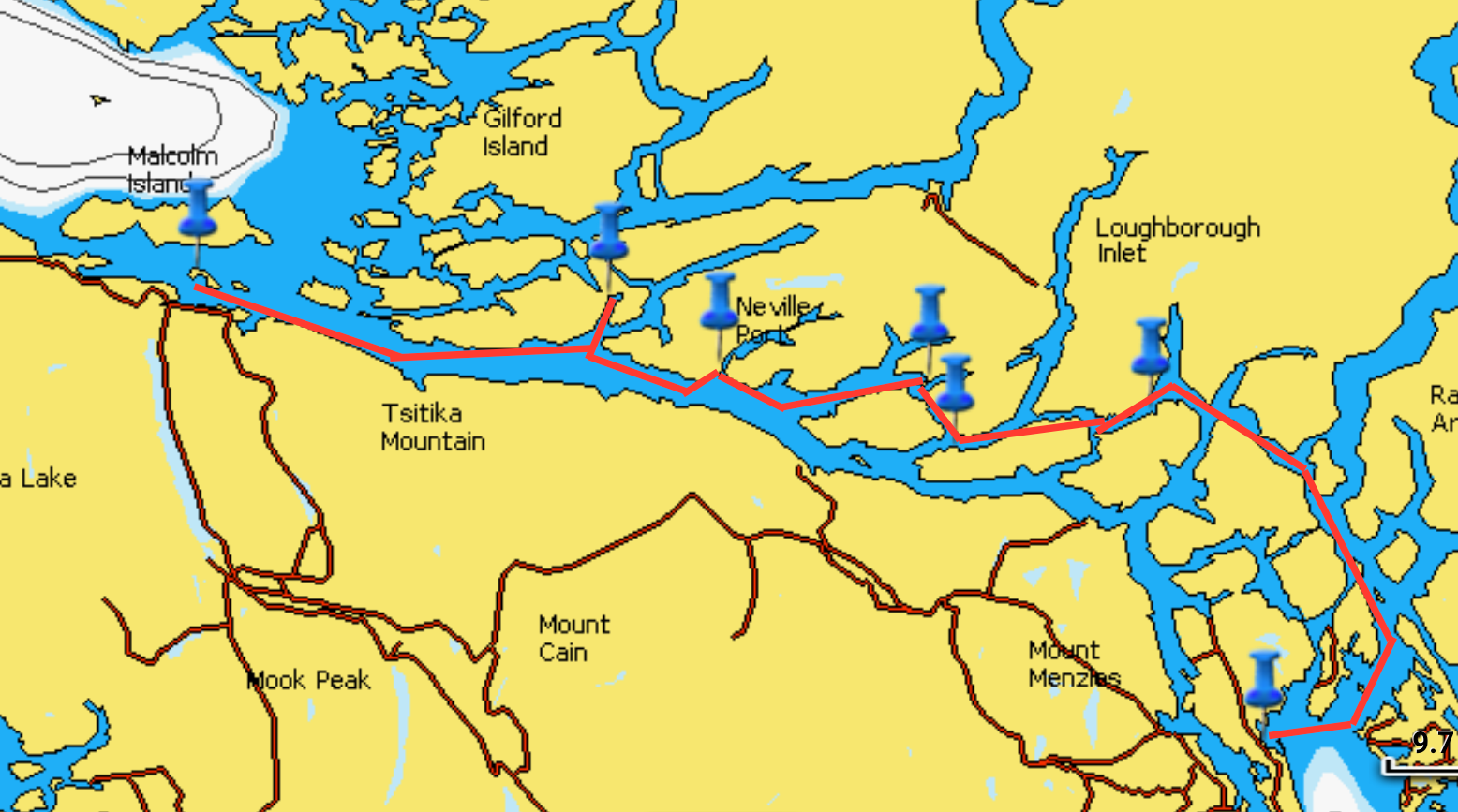
Shoal Bay
The first day we had about 15 knots of wind from the northwest, starting early in the morning. We sailed with a reefed mainsail and reefed genoa. For upwind sailing we’ve learned 15 knots is beyond question reefing territory – we’ll have a much more enjoyable, comfortable, and even faster ride that way. The way the channels turn and the wind funnels in though mountains, the wind wasn’t on our nose the whole way – it was generally at about 60 degrees to our waypoint, which is perfect for close hauled sailing with less tacking.
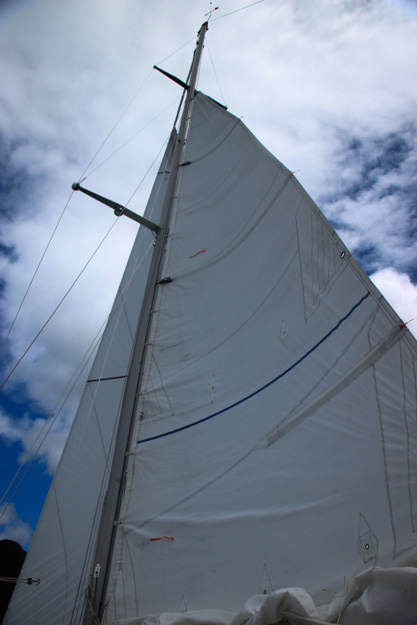
We had considered anchoring near Dent Lodge, but were really glad we continued on to Shoal Bay. The anchorage was secure and quiet, and we dinghied in to the Shoal Bay pub. There’s no town at Shoal Bay, so it’s really just a house that serves drinks to boaters in the bay. This was just our kind of place, and it was full of character. They made us mojitos with mint handpicked from their garden.
We did note a motorboat have trouble with kelp – attempting to anchor twice before giving up and leaving – but we had no trouble, along the western shore north of the dock.
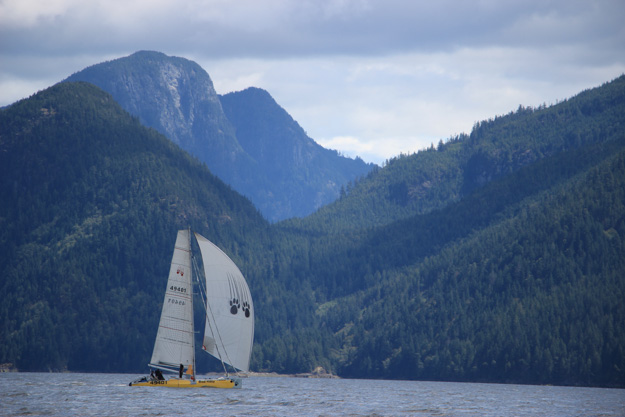
Shoal Bay to Forward Harbor
We left Shoal Bay around 9am and sailed upwind in a 4-6 knot breeze with a fellow sailor Hannes, who we met at the Shoal Bay Pub.
We got through Greenpoint Rapids around slack with no problem. But the channel after that had 15 knot winds on the nose, and it was changing to a flood current – opposing our travel, and meaning entering the next rapids (Whirlpool Rapids) would require fighting wind *and* current. A couple sailboats went for it, making very slow progress. We decided to wait for the evening slack, and found a temporary anchorage off of “Short Point” to the south of Whirlpool Rapids.
The problem with these two rapids is that there’s no official anchorage between them, and when traveling northwest on an ebb, it’s very difficult to hit both rapids near slack (unless you have a fast motorboat). If you go through Greenpoint at 30 minutes before slack, then Whirlpool is already 10 minutes from slack, and it’s 10 miles to get to it. If it takes you 1.5 hours to do the 10 miles (we had a 15-20 knot headwind), you’re over an hour late for slack. 1 hour past slack, Whirlpool is already flooding at 5 knots, according to the current predictions (we had big, fast tidal changes during the week we were going through because it was a new moon – a “spring tide”).
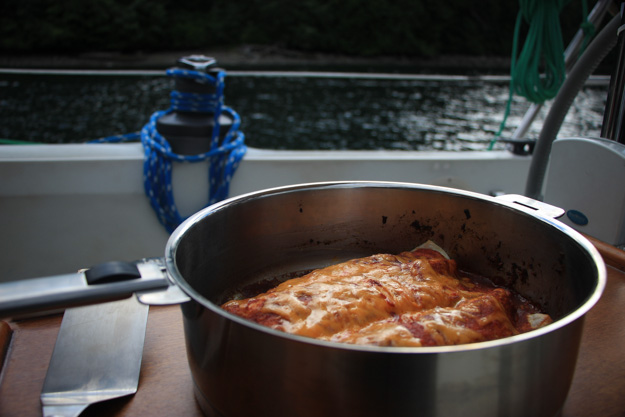
Natalie made these really awesome enchiladas
Forward Harbor to Port Neville
We left Forward Harbor early to ride the ebb – plus the wind was already up (at 6am). We tacked out into the channel, into 10 knot winds, and then 15, going through our reefing process. Turn off the wind to a broad reach, reef down the genoa, turn up to a close reach, reef down the main. As we got to Johnstone Strait the wind built to 20 knots. Our reefed genoa wasn’t doing too well at this point – roller furling genoas don’t reef well, especially upwind – they usually get a baggy spot in the middle.
We decided this was time to break out the high wind sails – basically our “storm mode”, though these weren’t storm conditions. We have an inner solent stay with a small staysail. We’ve never used it other than for practice. But for beating upwind in Johnstone Strait in 20-25 knots it was the right choice.
Unfortunately since we had left on an ebb (to have the current with us), but the wind was a typical northerly, sections of the strait were kicking up into giant tide rips. We got into a section where the waves were steep and short, and our boat speed got so reduced by the steep waves that we were wallowing. And our dinghy which we were towing (unfortunately not stowed on deck) was snapping at her line and slaloming down the waves.
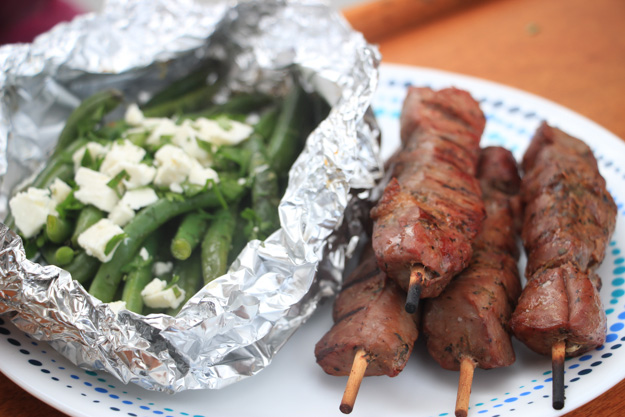
Even when the sailing is tough, we always prioritize eating well. In fact a good meal to look forward to is what gets us through the tiring times.
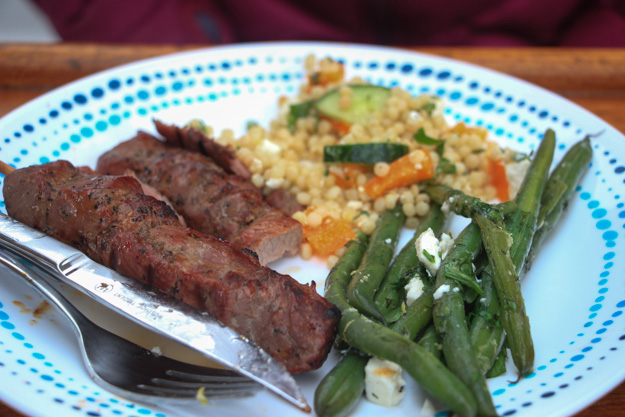
We found calmer waters towards the shoreline, and decided to take shelter in Port Neville (even though the strait was looking better by then).
Port Neville was a poor anchorage – one of the worst we’ve been in – mainly because there was 3 knots of current flowing through it, all night, plus 15 knots of wind. The current switches 180 degrees about every 6 hours, which is a great way to test your anchor’s reseting abilities. Not a great way to get a good night’s sleep though. Our Rocna did splendidly (sometimes after the current switched, I could hear it drag about 10 feet before resetting) but a 50’ powerboat in the anchorage wasn’t so lucky. He was solo on the boat, and only had a smallish CQR from what I could tell.
When you drag in a 3 knot current, you drag fast. I had always imagined dragging was a gradual thing, with time to react. But in a 3 knot current, I suppose it’s inaccurate to say he was dragging anchor – really his anchor had unseated and his boat was soaring backwards at 3 knots, with no chance of the anchor ever resetting at 3 knots. It was pretty scary.
Since he was solo, he had to run back and forth between the helm and the anchor windlass, while trying to avoid crashing into other boats, or the shore. I wanted to help, but didn’t have a way to – it all happened too fast. Eventually he went into the public dock with his windlass jammed and anchor still deployed.
In retrospect we probably wouldn’t stop in Port Neville next time if we could help it. The waves were getting better as the current turned to a flood, and the wind seemed to be lightening a bit. A 3 knot current puts a substantial strain on your anchoring gear (probably comparable to a 30 knot wind I would guess) and this can make a lot of noise – the water rushing past our hull made it sound like we were in a river, and our snubber line was actually vibrating rapidly with the force and strain. It wasn’t chafing, but made a lot of noise and made for a restless night worrying about whether we were going to drag out into Johnstone Strait like the powerboat almost did.
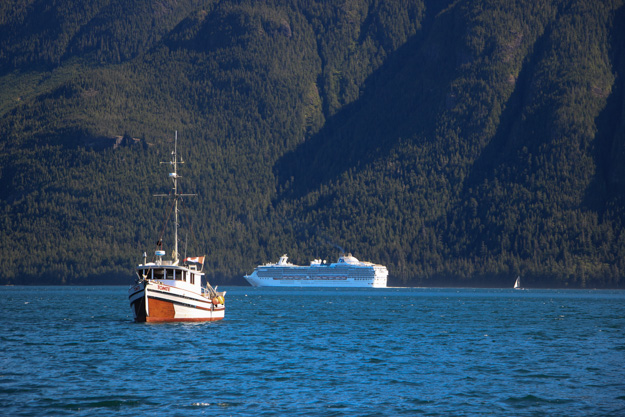
Another view out from Port Neville. Trawler in the foreground with the cruise ship and the sailboat out in Johnstone Strait
Johnstone Strait
Johnstone Strait is serious. The cruising guidebooks all talk about this, and now having experienced it we would agree. Yes you could get lucky and find a calm day on Johnstone Strait, or have a light wind going your way, but from what I can tell, most of the time Johnstone Strait is pretty tough. In our experience, the winds started before 6am, and ended after 9pm, if at all. We thought leaving early (6am) might allow us to beat the wind, as is often the formula in the Northwest, but that wasn’t the case this time – it was blowing 15-20 at 7am, and that continued till at least 2am.
You can’t necessarily wait for a calm day, unless you’re really really patient. For 5 days or so the strait had had 10-25 knot north winds, some days with a high wind advisory. We did finally get south winds, but our slow schedule and a bit of luck were what enabled that.
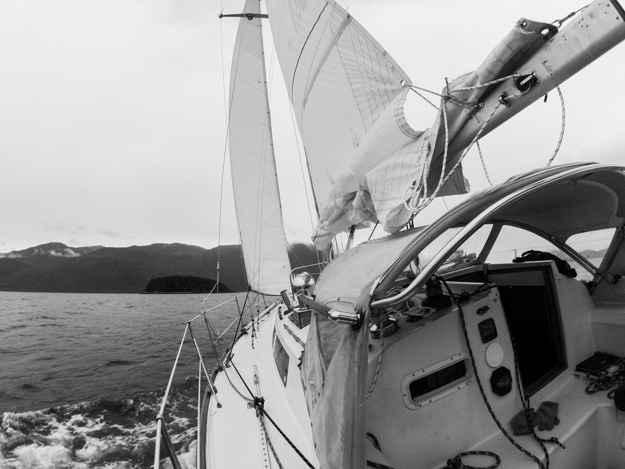
Flying the staysail and reefed main (yes the reefing isn’t perfect)
Port Neville to Port Harvey
Wednesday the forecast for Johnstone Strait was “light”, which is Canadian code for “we don’t really know if there will be wind but it’ll probably be less than 10.” Unlike the NOAA forecasts in the US, it seems Canadian marine forecasts don’t attempt wind predictions below 10 knots. They say “light” and don’t give a directional prediction (will it be south or north?), which leaves a big unknown. For Johnstone Strait, we discovered “light” doesn’t necessarily mean a calm day motoring – it meant 6-9 knots of wind behind us, which are pretty good sailing conditions. We sailed from Port Neville to Port Harvey, a short day (at anchor by 1pm), but we knew there’d be more south wind tomorrow for sure.
Port Harvey was a nicely protected anchorage, though not very pretty or peaceful. There was a major ship repair barge filling one of the anchorage nooks, heavy construction machinery operating noisily on another shore, and the marina dock had 14 powerboats, several running generators (there were only 3 sailboats to the 14 powerboats – we later learned this is pretty typical in the Broughtons).
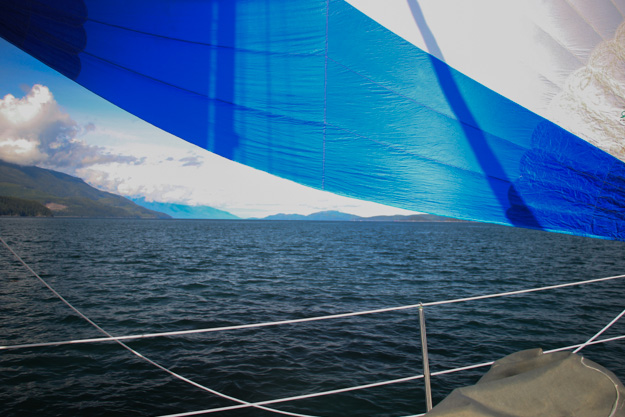
Flying the spinnaker, briefly, on the leg from Port Neville to Port Harvey.
Port Harvey to Alert Bay
Thursday the forecast was for 10-20 south wind, which got upgraded to 15-25 with a high wind warning. And Queen Charlotte strait to the north had a gale warning with 25-35 predicted. So we knew it’d be a tough day, but this time we had all the right ingredients – wind going our way, and current going our way (we left on the ebb). Plus we were prepared for it – we had the dinghy stowed on deck, foul weather gear on, and staysail ready to deploy if necessary.
It ended up being the first time we’ve sailed in high winds and can say we found it manageable and comfortable. We had 25 knot wind for about 3 hours of the 5 hour sail, and sailed with a reefed main and reefed genoa. There were some challenging tide rips in Johnstone Strait, but it was pretty manageable because we were going with the wind, and had current aligned with wind. We had up to 2 knots of current push, which made for exciting times when we were sailing at 7 knots with a 9 knot speed over ground.
We anchored in Alert Bay because it sounded like a good anchorage and an interesting town, but we should’ve just continued on to Port McNeil. Alert Bay turned out to be very poorly protected from wave swell, and it was the rolliest anchorage of our trip.
Coming Up
We’ve been in the Broughtons four or five days now, after reprovisioning in Port McNeil. The weather is a bit rainy, and considerably chillier than the areas we left, but we’re finding nice well protected anchorages that aren’t crowded at all – and hoping that the weather gets better next week.
